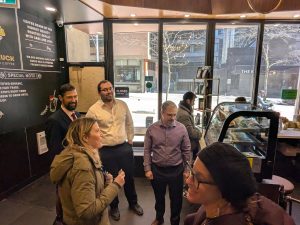As a graduate of the Toronto Jewish day school system, having attended both the Toronto Heschel School and the Anne and Max Tanenbaum Community Hebrew Academy of Toronto, I like to think I have a solid Jewish education. So far, it has served me well. When I’m in Israel, I can speak with Israelis. When I watch The Prince of Egypt, I can pinpoint the inaccuracies. However, on a recent trip through eastern Europe, I noticed that there were serious gaps in my education.
I cannot recall a year when I did not study the Holocaust in school. With the majority of my fellow students being Ashkenazi Jews, a great many of their ancestors came from eastern Europe. So if one of the reasons for studying the Holocaust is to acknowledge the plight of our ancestors, then why must instructors teach only of death and brutality, instead of life and prosperity?
This past April, I visited Prague. When I was researching what to do, many travel sites recommended a visit to the Jewish Quarter (known as the Josefov). I was intrigued, as I thought I knew a great deal about the Holocaust and the communities affected by it. Well, I was wrong.
READ: THE GLORIOUS ARCHITECTURE OF PRAGUE
The Josefov was ghettoized during the Second World War and, while its inhabitants were horribly mistreated, many of the buildings survived the war and remain in good condition. The remaining synagogues, mikvah and meeting halls reveal that there was once a thriving Jewish community in Prague.
When visiting these historic sites, I realized that the descriptor, “there existed bustling Jewish communities in eastern Europe,” was the extent of my knowledge of the pre-Holocaust European Jewish community. Just how much they flourished was never fully expressed to me. I saw this portion of the Jewish story as serious faces in black-and-white photographs and as the terrible images of death camps and cattle cars.
Yet in Prague’s Jewish Quarter alone, there are six synagogues (which are mostly still complete), a ceremonial hall, a town hall and a cemetery that’s overflowing with tombstones. Another massive synagogue, the Jerusalem Synagogue, stands outside of the Josefov. I was in awe of these synagogues, which were built between the 13th and 19th centuries. The synagogues I have visited in North America are maybe 100 years old or less. I had previously only been exposed to physical evidence of Jewish history when I was in Israel and when the Dead Sea Scrolls came to Toronto’s Royal Ontario Museum. Seeing these magnificent Jewish buildings and learning about life in eastern Europe’s vibrant Jewish communities made the reality of the cruelties of the Holocaust even sadder – something that I had not imagined possible.

Another knowledge gap I discovered related to Raoul Wallenberg, the namesake of my high school (TanenbaumCHAT’s Wallenberg Campus). I knew that Wallenberg was a righteous gentile, but didn’t know that he was Swedish, or how great an impact he had on Hungary’s Jewish community. I visited Budapest, where, in the garden of the Dohány Street Synagogue, I came upon a glistening stone plaque, engraved in gold, with hundreds of pebbles placed around its perimeter. I understood immediately that it was dedicated to a truly noble person and felt shocked to read Wallenberg’s name. I had to go to Budapest to learn why my school had its name. Maybe if we had learned more about the eastern European communities themselves, I would have known more about Wallenberg than just his name.
I strongly recommend a visit to eastern Europe for anyone who’s genuinely interested in Jewish history. My intention is not to criticize the education I received; I am an avid supporter of both the Toronto Heschel School and TanenbaumCHAT. I do, however, recommend that their curriculums focus more on European Jewish life before it was brutally demolished, because the more we focus a spotlight on strife, the less we appreciate the preceding joy.







